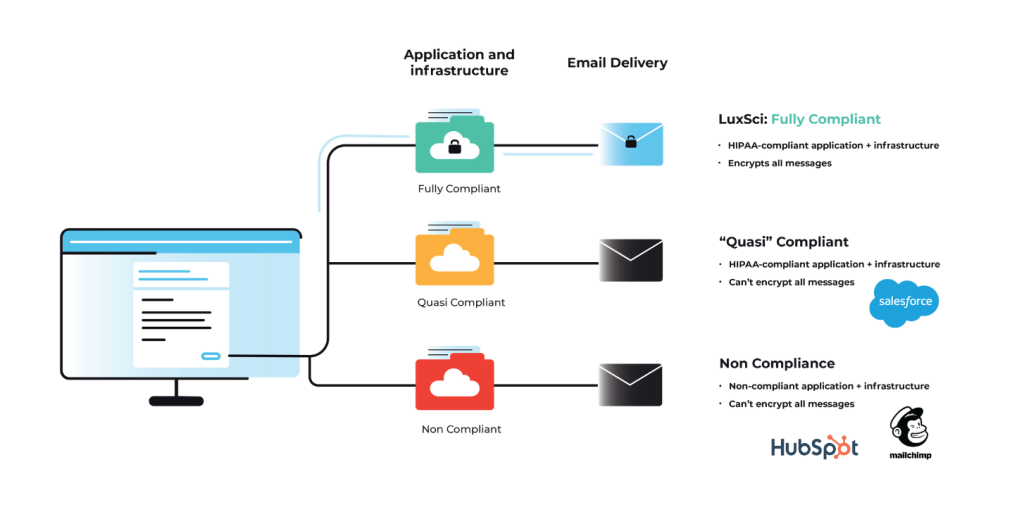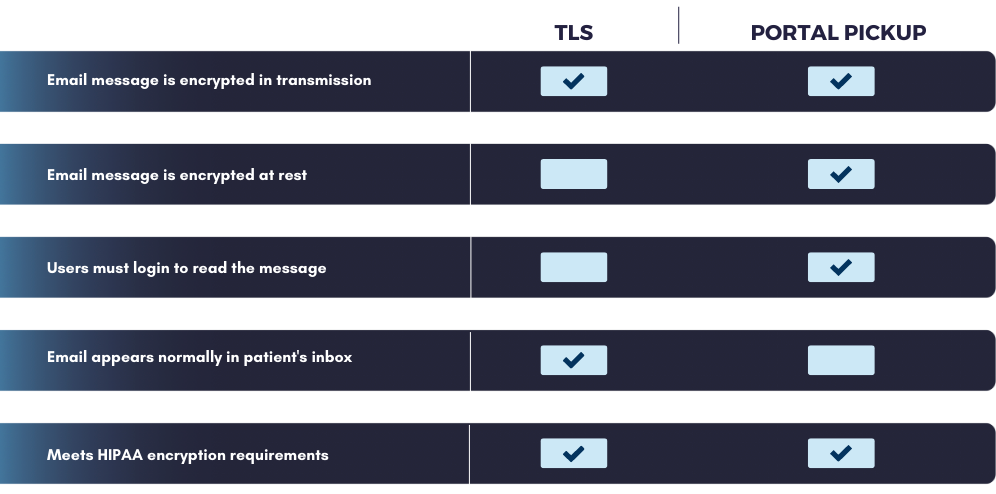With email security threats continuously increasing in number and sophistication, as well as healthcare companies requiring secure solutions to communicate with patients and customers, the need for HIPAA compliant email solutions has never been greater.
However, when looking for the right secure email services provider (ESP), healthcare organizations run the risk of making inaccurate assumptions about HIPAA compliance via what they learn from prospective vendors. This is due to the tendency for sales materials for HIPAA compliant email services, such as web pages or promotional videos, to highlight the strengths of the platform, while downplaying a healthcare company’s own role and responsibilities in securing protected health information (PHI).
With this firmly in mind, here are six key things that HIPAA compliant email salespeople don’t tell you about securing communications and achieving compliance.
1. The Shared Responsibility Model
Firstly, HIPAA compliant email salespeople are unlikely to emphasize the idea of shared responsibility when it comes to data security. This is the idea that two entities that share access to data, e.g., a healthcare company and their ESP, have a shared responsibility to preserve the privacy of that data.
In reality, most sales pitches explain the benefits and features of the solution, as opposed to stressing that compliance truly depends on how it’s configured and used. Now, that’s not to say that a salesperson is trying to hide this fact, as they’ll probably allude to training and configuration requirements. But, they’ll be less likely to make light of this and, more broadly, how shared responsibility factors into compliance.
2. A BAA Doesn’t Automatically Make You HIPAA Compliant
A business associate agreement (BAA) is essential for HIPAA compliance, but signing one doesn’t automatically make you compliant. Your organization still has to use the email delivery solution in a way that aligns with HIPAA regulations, which involves proper configuration, training, oversight, and reporting.
The misconception among some healthcare companies that a BAA equals compliance may be perpetuated by the term “HIPAA compliant email services provider”. This could give some the impression that the vendor is fully HIPAA compliant and, subsequently, in signing a BAA with them, the use of their services is fully compliant.
But, it’s not that simple.
Simply signing a BAA obscures the real effort involved in achieving compliance. There’s no official HIPAA seal of approval, and HIPAA compliant means that the solution is capable of being configured for compliant use, which is a shared responsibility. HIPAA compliant email salespeople are unlikely to volunteer this nuance, especially if their email solution requires considerable configuration or has a steep learning curve to use it securely.
3. Not All Solutions or Features Are HIPAA Compliant
Another key detail often underplayed by vendor sales materials of HIPAA compliant email solutions is that some of their features, or even entire services, aren’t covered by their BAAs, so they can’t be used to handle PHI.
These tools are referred to as “out of scope” and may include tools capable of integration with the email service, such as analytics or AI capabilities, but they don’t possess the cyber risk mitigation measures that align with HIPAA regulations. Perhaps the main reason for this is that many mass-market email delivery solutions, such as Microsoft 365 or Google Workspace, are designed for companies across all sectors. Consequently, while they can be HIPAA compliant, they weren’t developed from the ground up with the stringent regulatory demands of the healthcare industry in mind.
4. Solutions Are Not HIPAA Compliant “Out of The Box”
HIPAA compliant email salespeople may suggest that compliance is built into their platform, and healthcare organizations can use it to transmit PHI straight away, but this isn’t the case. Healthcare companies must still configure the email platform accordingly, as per the security requirements determined by their risk assessment, e.g., applying the right level of encryption.
Also, if the email service is difficult to configure for HIPAA compliance or if the vendor’s configuration documentation lacks detail, that presents another obstacle to its compliant use.
In addition to configuration, healthcare companies also have to implement access management controls and policies, establishing the extent to which each employee can access PHI in respect to their roles and responsibilities. From there, they will have to train their workforce on how to use the HIPAA compliant email solution securely, which may include those tools that fall outside the scope of your BAA with the vendor, and must not be used for the disclosure of patient data.
5. Essential Security Features Cost Extra
Another more egregious version of an ESP not being HIPAA compliant out of the box is having features required for compliance, such as encryption or audit logging, as premium add-ons and not included in the solution’s base pricing.
A vendor’s sales materials for its email service might list the necessary safeguards, but underemphasize the fact that only some versions of their platform are truly HIPAA compliant. Consequently, healthcare companies must confirm that the features required for HIPAA compliant email communications are included in the plan they’re purchasing.
6. The Importance of Staff Training on HIPAA
HIPAA compliant email salespeople are often remiss in stressing the need for additional workforce training alongside the deployment of their platform. A healthcare company’s employees must be trained on how to securely use the email client, how to ID potential threats, and best practices for including PHI in email communications, as well as the regulations tied to HIPAA and data security.
This includes educating users on the differences between regular and secure email, and what they must do to safeguard patient and customer data. Fortunately, secure email solutions from providers like LuxSci enable automated email encryption, and users do not need to take any additional actions to ensure encryption when sending emails.
Additionally, in some cases, employees will need to be trained on which tools or features do not align with HIPAA guidelines and must not be used to process PHI.
LuxSci: Fully HIPAA Compliant – No Hidden Surprises
LuxSci specializes in solutions that enable companies to carry out secure, personalized, and HIPAA compliant email communications and campaigns. With more than 20 years of experience and billions of emails sent for companies including Athenahealth, 1 800 Contacts, Lucerna Health and Rotech Healthcare, we’ve acquired invaluable experience in helping healthcare organizations enhance their engagement efforts, all while adhering to HIPAA regulations. In addition, LuxSci’s secure high-volume and marketing email solutions feature HIPAA-required security controls, including encryption, audit logging, and multi-factor authentication (MFA) by default, not as optional, hidden extras.
Contact us today to learn more about how LuxSci’s secure email solutions can help increase the ROI on your patient and customer outreach efforts, while safeguarding PHI in line with HIPAA requirements.











